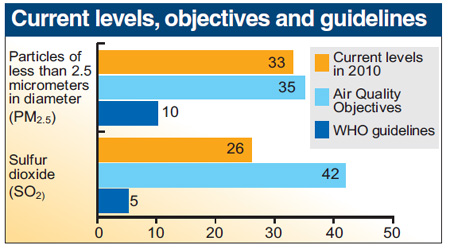HKU experts blast govt air quality plans
Updated: 2011-02-22 07:03
By Joseph Li(HK Edition)
|
|||||||||

The government's proposed Air Quality Objectives (AQO) cannot protect public health, medical professors from the University of Hong Kong criticized Monday.
The objectives are not only far below World Health Organization (WHO) benchmarks, said the academics, but in addition, the Environment Bureau has also erred in allowing more than enough exceedances of the local limits.
The professors urged the government to adopt the WHO benchmarks and review them regularly, as well as to inject financial resources to help the transport sector to replace the high-pollution-generating vehicles with more environmentally friendly ones.
The Environment Bureau responded that it has made reference to the WHO guidelines and advanced economies in formulating the objectives, taking into consideration the risk of air quality on public health in different places.
In fact, no country has fully adopted the WHO air quality benchmarks as the legal standards, the bureau said.
On the whole, Hong Kong's objectives and permitted exceedances are similar to those in the United States and the European Union, the bureau said.
Given that the proposed objectives cover a very wide scope, including power generation, vehicles and energy efficiency, as well as other areas closely associated with daily lives and business operations, the government said it has made every effort to devise a widely acceptable proposal.
In announcing an air quality analysis, Professor Anthony Hedley at the university's School of Public Health said the objectives were ineffective for various reasons, such as exclusion of population exposure, roadside levels and health impact assessment.
More importantly, Hedley said, the government rejected the WHO benchmarks and set extremely lax objectives, allowing additional exceedances.
"Secretary for the Environment Edward Yau only considers the WHO guidelines as long-term aspirational goals rather than medical emergencies," he said.
For example, the proposed level of particulates (PM2.5) is 35 and that of sulfur dioxide is 42, both of which are a far cry from the WHO benchmarks of 10 and 5.
The current level of particulates is, already high, at 33 and that of sulfur dioxide is at 26.
"As the proposed objectives are worse than the current levels, what good are they since they are set at such low levels and are so close to the current situation?" he queried.
As a result of the exceedances, an additional 1,860 avoidable deaths and 5.2 million doctor visits were associated, costing about HK$20 billion in economic losses, according to figures offered by the school.
Poor air quality will cause respiratory diseases, pneumonia, asthma and chronic diseases such as diabetes, said Hedley's fellow, Professor Lam Tai-hing.
"The AQO is misleading and damaging to public health. Even though when the government says the air quality is okay, it is not that good because the AQO is based on very low levels," Lam said.
The objectives will legally allow the Environment Impact Assessment Ordinance to permit high levels of emissions and worsen the air quality, he said.
Even though the WHO guidelines may not assure complete safety because they were devised five years ago, the government should adopt them and review them periodically to suit the local environment, said Lam.
China Daily
(HK Edition 02/22/2011 page1)